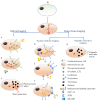Reporter Transgenes for Monitoring the Antitumor Efficacy of Recombinant Oncolytic Viruses
- PMID: 36348722
- PMCID: PMC9611865
- DOI: 10.32607/actanaturae.11719
Reporter Transgenes for Monitoring the Antitumor Efficacy of Recombinant Oncolytic Viruses
Abstract
Accurate measurement of tumor size and margins is crucial for successful oncotherapy. In the last decade, non-invasive imaging modalities, including optical imaging using non-radioactive substrates, deep-tissue imaging with radioactive substrates, and magnetic resonance imaging have been developed. Reporter genes play the most important role among visualization tools; their expression in tumors and metastases makes it possible to track changes in the tumor growth and gauge therapy effectiveness. Oncolytic viruses are often chosen as a vector for delivering reporter genes into tumor cells, since oncolytic viruses are tumor-specific, meaning that they infect and lyse tumor cells without damaging normal cells. The choice of reporter transgenes for genetic modification of oncolytic viruses depends on the study objectives and imaging methods used. Optical imaging techniques are suitable for in vitro studies and small animal models, while deep-tissue imaging techniques are used to evaluate virotherapy in large animals and humans. For optical imaging, transgenes of fluorescent proteins, luciferases, and tyrosinases are used; for deep-tissue imaging, the most promising transgene is the sodium/iodide symporter (NIS), which ensures an accumulation of radioactive isotopes in virus-infected tumor cells. Currently, NIS is the only reporter transgene that has been shown to be effective in monitoring tumor virotherapy not only in preclinical but also in clinical studies.
Keywords: NIS; deep-tissue imaging; oncolytic viruses; optical imaging; reporter transgenes; tumor cell.
Copyright ® 2022 National Research University Higher School of Economics.
Figures

Similar articles
-
Virotheranostics, a double-barreled viral gun pointed toward cancer; ready to shoot?Cancer Cell Int. 2020 Apr 23;20:131. doi: 10.1186/s12935-020-01219-6. eCollection 2020. Cancer Cell Int. 2020. PMID: 32336951 Free PMC article. Review.
-
Ex vivo infection of live tissue with oncolytic viruses.J Vis Exp. 2011 Jun 25;(52):2854. doi: 10.3791/2854. J Vis Exp. 2011. PMID: 21730946 Free PMC article.
-
The use of the NIS reporter gene for optimizing oncolytic virotherapy.Expert Opin Biol Ther. 2016;16(1):15-32. doi: 10.1517/14712598.2016.1100162. Epub 2015 Oct 12. Expert Opin Biol Ther. 2016. PMID: 26457362 Free PMC article. Review.
-
In Vivo Estimation of Oncolytic Virus Populations within Tumors.Cancer Res. 2018 Oct 15;78(20):5992-6000. doi: 10.1158/0008-5472.CAN-18-0447. Epub 2018 Aug 16. Cancer Res. 2018. PMID: 30115692 Free PMC article.
-
Dual therapy of ovarian cancer using measles viruses expressing carcinoembryonic antigen and sodium iodide symporter.Clin Cancer Res. 2006 Mar 15;12(6):1868-75. doi: 10.1158/1078-0432.CCR-05-1803. Clin Cancer Res. 2006. PMID: 16551872
Cited by
-
Oncolytic Viruses in the Era of Omics, Computational Technologies, and Modeling: Thesis, Antithesis, and Synthesis.Int J Mol Sci. 2023 Dec 12;24(24):17378. doi: 10.3390/ijms242417378. Int J Mol Sci. 2023. PMID: 38139207 Free PMC article. Review.
References
-
- Lawler S.E., Speranza M.C., Cho C.F., Chiocca E.A.. JAMA Oncol. 2017;3(6):841. - PubMed
-
- Romanenko M.V., Dolgova E.V., Osipov I.D., Ritter G.S., Sizova M.S., Proskurina A.S., Efremov Y.R., Bayborodin S.I., Potter E.A., Taranov O.S.. Anticancer Res. 2019;39(11):6073–6086. - PubMed
-
- Kochneva G.V., Sivolobova G.F., Tkacheva A.V., Gorchakov A.A., Kulemzin S.V., Journal of Molecular Biology. 2020;54(1):3–16. - PubMed
LinkOut - more resources
Full Text Sources
